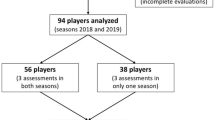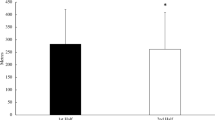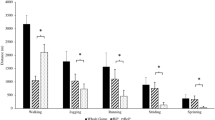Abstract
Purpose
The current study aimed to investigate the sprint performances of senior Camogie players between halves of play and between positions.
Methods
Forty-three (n = 43) elite female Camogie players (23 ± 5 years; 174 ± 5 cm; 68 ± 9 kg) wore 10-Hz GPS devices (STATSports, Apex) to record data in 20 competitive matches during the 2018–2020 season. The total sprint distance (TSD), number of sprints (NOS) < 20 m and ≥ 20 m, and the NOS 80–90% and > 90% of the player’s peak speed, the mean sprint duration, and between-sprint duration were analyzed.
Results
The TSD was 162 ± 102 m accumulated by 9 ± 5 NOS. The NOS < 20 m and ≥ 20 m was 7 ± 3 and 3 ± 2, respectively. The NOS 80–90% and > 90% was 6 ± 3 and 3 ± 3, respectively. The mean sprint duration and between-sprint duration was 3 ± 1 s and 6:29 ± 3:12 min:sec, respectively. A second-half decrease was observed for TSD (ES = − 0.24), NOS (ES = − 0.33), NOS < 20 m (ES = − 0.50) and ≥ 20 m (ES = − 1.00), and NOS > 90% (ES = − 0.63). Full-backs accumulated less TSD and NOS than half-backs (ES = − 1.07, − 1.21, respectively), midfielders (ES = − 1.54, − 1.41, respectively) and half-forwards (ES = − 0.91, − 0.92, respectively). Midfielders and half-forwards had a longer mean length of sprint (ES = 0.88, 0.92, respectively) and mean sprint duration (ES = 0.66, 0.60, respectively) compared to full-backs. Half-backs performed a greater NOS < 20 m than full-backs (ES = 1.17).
Conclusion
The current results provide a sprint profile of Camogie match-play, where positional differences should be considered in training.
Similar content being viewed by others
References
Young D, Mourot L, Coratella G (2018) Match-play performance comparisons between elite and sub-elite hurling players. Sport Sci Health 14:201–208. https://doi.org/10.1007/s11332-018-0441-6
Young D, O’Grady M, Coratella G (2020) The match-play running performance of elite Camogie players across halves of play. Sport Sci Health. https://doi.org/10.1007/s11332-020-00672-0
Young D, Collins K, Mourot L, Coratella G (2019) The match-play activity cycles in elite U17, U21 and senior hurling competitive games. Sport Sci Health 15:351–359. https://doi.org/10.1007/s11332-018-00523-z
Duthie G, Pyne D, Hooper S (2003) The reliability of video based time motion analysis. J Hum Mov Stud 44:259–272
Malone S, Keane J, Owen A et al (2021) The effect of a periodized small-sided games intervention in hurling on physical and physiological measures of performance. Sport Sci Health 17:403–413. https://doi.org/10.1007/s11332-020-00703-w
Egan B, Young D, Collins K et al (2021) The between-competition running demands of elite hurling match-play. Sports 9:145. https://doi.org/10.3390/sports9110145
McGuinness A, Malone S, Hughes B et al (2019) The physcial activity and physiological profiles of elite international female field hockey players across the quaters of competitive match-play. J Strength Cond Res 33:2513–2522
Vescovi JD (2012) Sprint profile of professional female soccer players during competitive matches: female athletes in motion (FAiM) study. J Sports Sci 30:1259–1265. https://doi.org/10.1080/02640414.2012.701760
Vescovi JD, Goodale T (2015) Physical demands of women’s rugby sevens matches: female athletes in motion (FAiM) study. Int J Sports Med 36:887–892. https://doi.org/10.1055/s-0035-1548940
Hauer R, Tessitore A, Hauer K, Tschan H (2019) Activity profile of international female lacrosse players. J Strength Cond Res. https://doi.org/10.1519/jsc.0000000000003253
Young D, Coratella G, Malone S et al (2019) The match-play sprint performance of elite senior hurlers during competitive games. PLoS ONE 14:1–14. https://doi.org/10.1371/journal.pone.0215156
Young D, Coratella G (2021) Acceleration, deceleration and dynamic stress load in elite hurling: a between-quarter and between-position comparison. Sports 9:10. https://doi.org/10.3390/sports9010010
Young D, Hennessy L, Coratella G (2021) The ball-in-play vs. ball-out-of-play match demands of elite senior hurling. Sport Sci Health. https://doi.org/10.1007/s11332-020-00725-4
Young D, Malone S, Collins K et al (2019) Metabolic power in hurling with respect to position and halves of match-play. PLoS ONE 14:1–12. https://doi.org/10.1371/journal.pone.0225947
Young D, Kilty J, Hennessy L, Coratella G (2020) The running performance decrement in elite hurling. Appl Sci 10:1–9. https://doi.org/10.3390/app10228191
Young D, Mourot L, Beato M, Coratella G (2020) Match-play demands of elite U17 hurlers during competitive matches. J Strength Cond Res 34:1982–1989. https://doi.org/10.1519/jsc.0000000000002945
Young D, Malone S, Beato M et al (2020) Identification of maximal running intensities during elite hurling match-play. J Strength Cond Res 34:2608–2617. https://doi.org/10.1519/jsc.0000000000002674
Misseldine ND, Blagrove RC, Goodwin JE (2021) Speed demands of womenʼs rugby sevens match play. J Strength Cond Res 35:183–189. https://doi.org/10.1519/jsc.0000000000002638
Little T, Williams AG (2006) Effects of differential stretching protocols during warm-ups on high-speed motor capacities in professional soccer players. J Strength Cond Res 20:203–207. https://doi.org/10.1519/R-16944.1
Jennings D, Cormack S, Coutts AJ et al (2010) Variability of GPS units for measuring distance in team sport movements. Int J Sports Physiol Perform 5:565–569. https://doi.org/10.1123/ijspp.2014-0294
McGuinness A, Malone S, Hughes B, Collins K (2019) The physical activity and physiological profiles of elite international female field hockey players across the quarters of competitive match-play. J Strength Cond Res 33:2513–2522. https://doi.org/10.1519/JSC.0000000000002483
Mendez-Villanueva A, Buchheit M, Kuitunen S et al (2011) Age-related differences in acceleration, maximum running speed, and repeated-sprint performance in young soccer players. J Sports Sci 29:477–484. https://doi.org/10.1080/02640414.2010.536248
Al Haddad H, Simpson BM, Buchheit M et al (2015) Peak match speed and maximal sprinting speed in young soccer players: effect of age and playing position. Int J Sports Physiol Perform 10:888–896. https://doi.org/10.1123/ijspp.2014-0539
Beato M, Coratella G, Stiff A, Dello IA (2018) The validity and between-unit variability of GNSS units (STATSports apex 10 and 18 Hz) for measuring distance and peak speed in team sports. Front Physiol 21:1288. https://doi.org/10.3389/fphys.2018.01288
Maddison R, Ni Mhurchu C (2009) Global positioning system: a new opportunity in physical activity measurement. Int J Behav Nutr Phys Act 6:73. https://doi.org/10.1186/1479-5868-6-73
Young D, Mourot L, Beato M, Coratella G (2018) The match heart-rate and running profile of elite under 21 hurlers during competitive match-play. J Strength Cond Res 32:2925–2933. https://doi.org/10.1519/JSC.0000000000002558
McGuinness A, McMahon G, Malone S et al (2020) Monitoring wellness, training load, and running performance during a major international female field hockey tournament. J Strength Cond Res 34:2312–2320. https://doi.org/10.1519/jsc.0000000000002835
Hopkins WG (2007) A spreadsheet for deriving a confidence interval, mechanistic inference and clinical inference from a p value. Sportscience 11:16–20
Macutkiewicz D, Sunderland C (2011) The use of GPS to evaluate activity profiles of elite women hockey players during match-play. J Sports Sci 29:967–973
Trewin J, Meylan C, Varley MC, Cronin J (2018) The match-to-match variation of match-running in elite female soccer. J Sci Med Sport 21:196–201. https://doi.org/10.1016/j.jsams.2017.05.009
Ryan S, Coutts AJ, Hocking J, Kempton T (2017) Factors affecting match running performance in professional Australian football. Int J Sports Physiol Perform 12:1199–1204. https://doi.org/10.1123/ijspp.2016-0586
Mangan S, Malone S, Ryan M et al (2017) The influence of match outcome on running performance in elite Gaelic football. Sci Med Footb 1:272–279. https://doi.org/10.1080/24733938.2017.1363907
Lago C, Casais L, Dominguez E, Sampaio J (2010) The effects of situational variables on distance covered at various speeds in elite soccer. Eur J Sport Sci 10:103–109. https://doi.org/10.1080/17461390903273994
Mangan S, Ryan M, Devenney S et al (2017) The relationship between technical performance indicators and running performance in elite Gaelic football. Int J Perf Anal Sport 17:706–720
Funding
No funding.
Author information
Authors and Affiliations
Contributions
MO’G and DY have given substantial contributions to the conception or the design of the manuscript, and MO’G, DY and GC to acquisition, analysis, and interpretation of the data. All authors have participated to drafting the manuscript and revised it critically. All authors read and approved the final version of the manuscript.
Corresponding author
Ethics declarations
Conflict of interest
The authors have no conflict of interest.
Ethical approval and Informed consent
After ethical approval, the participants were informed of the purpose of the study along with the procedures and potential risks involved. They were also informed that they were free to withdraw at any time throughout the study. Written informed consent and medical declaration were obtained from the participants in line with the procedures set by Limerick Institute of Technology’s Research Ethics Committee.
Additional information
Publisher's Note
Springer Nature remains neutral with regard to jurisdictional claims in published maps and institutional affiliations.
Supplementary Information
Below is the link to the electronic supplementary material.
Rights and permissions
About this article
Cite this article
O’Grady, M., Young, D., Collins, K. et al. An investigation of the sprint performance of senior elite camogie players during competitive play. Sport Sci Health 18, 905–913 (2022). https://doi.org/10.1007/s11332-021-00874-0
Received:
Accepted:
Published:
Issue Date:
DOI: https://doi.org/10.1007/s11332-021-00874-0




